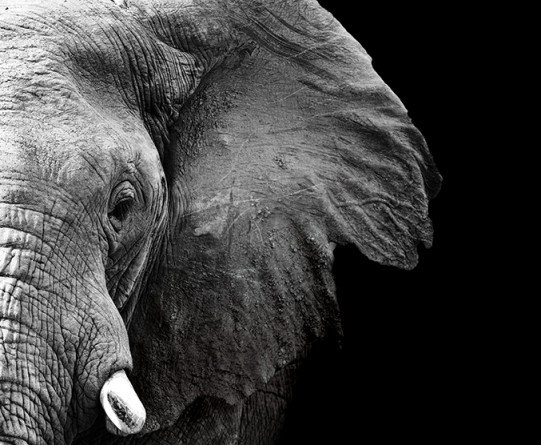If an object of great beauty costs a life to produce, is it something we can really afford?

The kiss of the elephant was firm but gentle. It was delivered on my cheek, after which she dropped her trunk and took my hand. I looked up into her eyes and … was that a twinkle of amusement?
Our meeting place – a muddy paddock in the Magaliesberg – wasn’t romantic, but in that magic moment it didn’t seem to matter. I fell in love, right there, with an entire species.
Then I remembered the small ivory Buddha I’d been given years earlier. Its creation had probably required the death of a great creature like the one with the lips of her trunk round my hand. This realisation – and the contradiction that murder was required to make the figure of one of Earth’s most peace-loving saints – made my ears ring.
‘Sorry,’ I said, but she just kept on holding my hand.
It turned out that I wasn’t alone in avoiding the connection between a beautifully carved ivory object and the death of hundreds of thousands of elephants. In China, where most such carving takes place, a recent survey by HorizonKey in the cities of Beijing, Shanghai and Guangzhou found that seven out of 10 Chinese don’t know that ivory comes only from dead elephants.
It noted that more than half of those who did know thought poaching wasn’t common and a third thought ivory came from natural elephant mortality. What they weren’t likely to acknowledge – given the ancient Chinese craft of ivory carving – is that, according to the World Wildlife Fund, around 30 000 African elephants are poached every year to support the huge market in exquisite collectables.
‘Evidence is irrefutable,’ said a WWF report released this year, ‘that China bears the main responsibility for the elephant poaching crisis, yet it continues to hide behind a façade of denial.’
In 1989, after two decades in which the world’s elephant population was halved, the Convention on International Trade in Endangered Species of Wild Fauna and Flora (CITES) banned the trade in elephant ivory. Eight years later, after pressure from South Africa, Zimbabwe, Botswana and Namibia, it down-listed elephant protection and allowed a one-off sale of ivory stockpiles from these countries. In 2007, it approved another stockpile sale.
A report, Making a Killing by the International Fund for Animal Welfare (IFAW), has highlighted the tragedy of these decisions. Since the sales, there’s been a dramatic decline in wild elephants and poaching has escalated to a point where the future of the creatures is in doubt. (The numbers of secretive Central African forest elephants are down by 62 percent from 2002 levels and, while poaching is low in South Africa, it’s high on its borders, so it’s just a matter of time.)
According to the report, the stockpile sales created confusion among consumers in China, who believed the ivory trade was legal, effectively breaking the integrity of the ban. ‘The intention … was to flood the market with legal ivory in order to reduce its price. However, the reverse has happened. The influx of legal ivory into the market in China has spurred demand, pushed up prices and created a grey market in which legal ivory provides outlets and opportunities for illegal ivory to be sold.’
In an attempt to stem poaching, China banned all ivory imports and required every carved item sold to be accompanied by an official ‘clean ivory’ certificate. But of 158 retail shops and carving factories visited by IFAW, 101 weren’t licensed. Illegals outnumbered legal outlets nearly six to one. Only 57 were licensed, representing a compliance rate of just 36 percent. Among the licensed facilities, 60 percent were found to violate the system in some way.
Lack of strong law enforcement, combined with low priority for wildlife crime in the legal system, makes ivory trafficking in China a high-profit and low-risk criminal activity. So business is booming.
Because elephant populations worldwide are declining, ivory is promoted as having ‘inflation-proof investment value’ and owning and gifting ivory demonstrates status. The owner of a carving factory in Fuzhou told IFAW investigators that no matter how many ivory products his factory produced and how high the prices, there were willing buyers who bought ivory as ‘white gold’.
The flow of poached ivory is recently finding new routes. As Beijing increases its investments in Africa, Chinese nationals (workers, businessmen and visitors) are reaching every corner of the continent – and a rising number of them are becoming involved in illicit ivory trading.
In response to increased poaching, Kenya, South Africa and Mozambique have been holding talks about co-operation in wildlife conservation and anti-poaching. At a meeting in Bangkok this year, CITES agreed to take action against Kenya, China, Malaysia, the Philippines, Thailand, Uganda, Tanzania and Vietnam – the countries believed to have failed to clamp down on large-scale illegal ivory trade – if they show little or no progress in stopping it. Its message: stop poaching or face sanctions against all cross-border species trade.
It’s a start, and those who love elephants are waiting to see its effectiveness. But I’m left with a private moral dilemma. The correct approach to ivory stocks should be to burn them, as Kenya and Botswana did. But should I burn my exquisite little Buddha? It’s a severe test of my commitment to an elephant that once held my hand.
Gallery: 10 of the best elephant photos you’ll ever see
Best places to see elephants
The best places to see thriving and protected wild elephant populations in Southern Africa are Kruger, Chobe, Etosha, Hwange, Luangwa, Amboseli, Tarangire, Hluhluwe-Umfolozi and Addo national parks as well as smaller reserves such as Tembe, Madikwe, Lapalala, Marakele and Pilanesberg. To hold hands with an elephant as I did earlier this year, drop in at the Elephant Sanctuary in the Magaliesberg (www.elephantsanctuary.co.za).

















